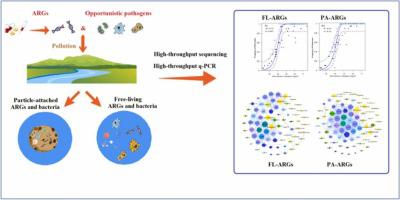Journal of Hazardous Materials ( IF 12.2 ) Pub Date : 2021-10-20 , DOI: 10.1016/j.jhazmat.2021.127564 Qiaoling Yu 1 , Jiawei Yang 1 , Wanghong Su 1 , Tongtong Li 2 , Tianshu Feng 1 , Huan Li 3

|
Suspended particles in water can shelter both microorganisms and contaminants. However, the emerging pollutants antibiotic resistance genes (ARGs) in free-living (FL) or particle-attached (PA) bacteria in aquatic environments are less explored. In this study, we compared the free-living and particle-attached ARGs during four seasons in the Yellow River using high-throughput quantitative PCR techniques and 16S rRNA gene sequencing. Our results demonstrated that both the free-living water and particles were dominated by tetracycline and beta-lactamase resistance genes. The PA-ARGs had a higher absolute abundance than FL-ARGs in the Yellow River, regardless of the season. Both PA-ARGs and FL-ARGs had the highest absolute abundance and diversity during winter. Mobile genetic elements (MGEs) were the dominant driver for both size-fractionated ARGs. However, the microbiome had less influence on PA-ARG profiles than the FL-ARG profiles, while the effects of the heavy metals on ARGs were negligible. The community assembly of both FL-ARG and PA-ARG can be explained by neutral processes. Several opportunistic pathogens (e.g., Escherichia coli) associated with human health exhibited a higher relative abundance in the particles than during a free-living lifestyle. Parts of these pathogens were potential ARG hosts. As such, it is important to monitor the ARGs and opportunistic pathogens from size-fractionated bacteria and develop targeted strategies to manage ARG dissemination and opportunistic pathogens to ensure public health.
中文翻译:

在确定黄河中颗粒附着和自由生存的抗性组时,重金属和微生物组比移动遗传元素的驱动力可以忽略不计
水中的悬浮颗粒可以保护微生物和污染物。然而,对水生环境中自由生活 (FL) 或颗粒附着 (PA) 细菌中新兴污染物抗生素抗性基因 (ARG) 的探索较少。在这项研究中,我们使用高通量定量 PCR 技术和 16S rRNA 基因测序比较了黄河四个季节中自由生活和附着颗粒的 ARGs。我们的结果表明,自由生活的水和颗粒都由四环素和β-内酰胺酶抗性基因主导。无论季节如何,黄河中 PA-ARGs 的绝对丰度均高于 FL-ARGs。PA-ARGs 和 FL-ARGs 在冬季具有最高的绝对丰度和多样性。移动遗传元件 (MGEs) 是两种大小分级 ARGs 的主要驱动力。然而,微生物组对 PA-ARG 谱的影响小于 FL-ARG 谱,而重金属对 ARGs 的影响可以忽略不计。FL-ARG 和 PA-ARG 的社区组装可以用中性过程来解释。几种机会性病原体(例如,与人类健康相关的大肠杆菌( Escherichia coli)在颗粒中的相对丰度高于自由生活的生活方式。这些病原体中的一部分是潜在的 ARG 宿主。因此,重要的是监测来自大小分级细菌的 ARG 和机会性病原体,并制定有针对性的策略来管理 ARG 传播和机会性病原体,以确保公众健康。











































 京公网安备 11010802027423号
京公网安备 11010802027423号